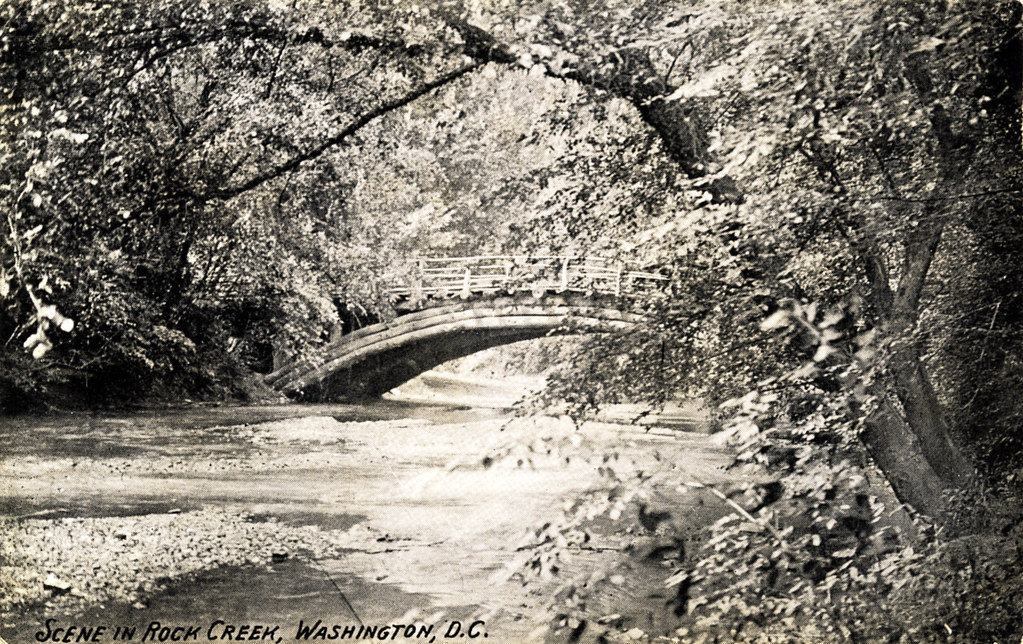Perhaps my favorite vintage postcard of
Rock Creek Park is this one of the "Old Rustic Bridge." Such a lush scene, with dappled sunlight on the creek and that wonderful bridge! Where was it? The card states only that "Rock Creek Park is famed for the beauty of its Natural Scenery. The Old Log Bridge is one of the favorite spots for many people." The second postcard has no caption.
 |
| Old Rustic Log bridge as seen from the south (author's collection). |
The bridge was located along the southern edge of the
National Zoological Park. If you look at the Zoo's current
map, you'll see a park service road ("Zoo Staff Only") that leads to a bridge over the creek heading to the south. That is the former location of the old rustic log bridge, and rather than a service road, it used to carry vehicular traffic through the lower area of the Zoo, providing a connection between the Rock Creek and Potomac Parkway to the south and Beach Drive to the north. This was before the tunnel was constructed in the 1960s that now carries Beach Drive along the other (east) side of the creek. While the road is now closed to vehicular traffic, you can get to it easily on foot.
 |
| The approach from the Zoo side of the creek (author's collection). |
The rustic log bridge was designed and built in about 1895 by Glenn Brown, a prominent Washington architect and future secretary of the
American Institute of Architects. Brown was very active in city planning in Washington and would be a major proponent of the Senate Park (McMillan) Commission, formed in 1901. Like
Frederick Law Olmsted, Glenn Brown was committed believer in the City Beautiful movement and its tenets that architecture should blend in harmoniously with its surroundings. Regarding Rock Creek Park in particular, Brown wrote that artificial structures should be built "only in the most picturesque manner, so the people can see and enjoy their natural beauties." Brown designed the rustic log bridge to provide a temporary connection to the new Zoo across the creek, but it remained there for almost 20 years and would allow access through the Zoo to Beach Drive, which was completed just to the north in 1901. [For more about Glenn Brown, see "Glenn Brown and the Planning of the Rock Creek Valley" by William B. Bushong in
Washington History, Spring/Summer 2002.]
 |
| The bridge as seen from the north (From author's collection; professionally scanned by Austin J. Cuttino). |
The bridge spanned 75 feet of the creek and was supported by a single grand arch made of large oak logs. The logs were formed into two curved ribs on each side of the arch. Each rib was made of three logs, one placed on top of the other and then bolted together. The road surface was supported by a deck of logs laid crosswise. In fact, the entire bridge structure was made of logs, including the segmental arch and rustic parapets. According to Zack Spratt ("Rock Creek's Bridges" in
Records of the Columbia Historical Society 1953-1956), the bridge cost $3,550. The bridge was widely admired in architectural and engineering circles for its grace and beauty and for fitting so well into its setting. It was cited as an outstanding park bridge design in the March 30, 1901, edition of
American Architect and Building News. The success of the log bridge's rustic design set a precedent for the later construction of the also-much-loved
Boulder Bridge further north along Beach Drive in 1902.
.jpg) |
| An early 1900s view of the gneiss bridge that replaced the rustic log bridge (Source: Library of Congress) |
However attractive it may have been, it was still a log bridge, and it was not destined to last a long time. The concrete bridge that stands there now, which is faced with rough gneiss stone, replaced the old rustic log bridge in 1913. As Bushong notes, Brown's advocacy of the McMillan Plan may have led to resistance from certain key members of Congress to fund improvements in Rock Creek Park, and the replacement bridge didn't get built until passage of a law in 1912 requiring D.C. Government involvement in designing all Zoo bridges. The new bridge cost $20,000 and was designed by W. A. Draper, assistant engineer of bridges for the District. According to the
Washington Post, the blue gneiss facing for the bridge was obtained from quarries along the Virginia side of the Potomac above Washington. This design, which can also be considered rustic, became typical for bridges and retaining walls in the park for many years. While attractive, the bridge would never have the same romantic draw as the old log bridge it replaced.
 |
| The gneiss bridge, built in 1913, as it appears today. |


.jpg)





Comments
Post a Comment